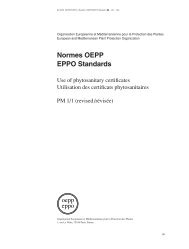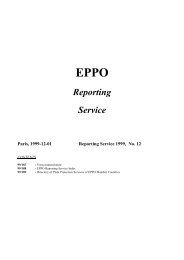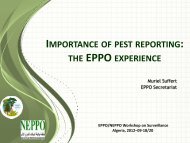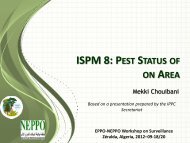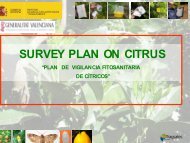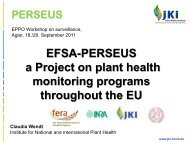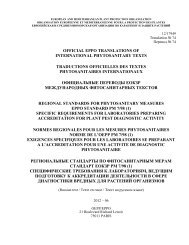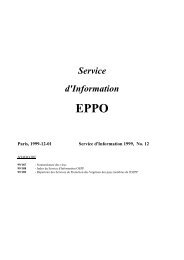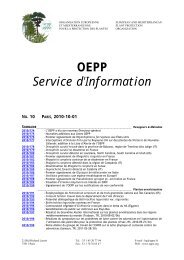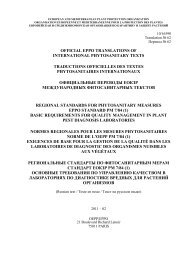Introduction of new fungicides for Septoria Leaf Blotch Control
Introduction of new fungicides for Septoria Leaf Blotch Control
Introduction of new fungicides for Septoria Leaf Blotch Control
You also want an ePaper? Increase the reach of your titles
YUMPU automatically turns print PDFs into web optimized ePapers that Google loves.
<strong>Introduction</strong> <strong>of</strong> <strong>new</strong> <strong>fungicides</strong> <strong>for</strong><br />
<strong>Septoria</strong> <strong>Leaf</strong> <strong>Blotch</strong> <strong>Control</strong><br />
Andy Leadbeater<br />
Head <strong>of</strong> Fungicide Technical R&D, Basel Switzerland<br />
EPPO Workshop on azole <strong>fungicides</strong> and <strong>Septoria</strong><br />
leaf blotch control, Rothamsted December 2010
2<br />
Agriculture is innovation driven…<br />
Percent <strong>of</strong><br />
sales<br />
14<br />
12<br />
10<br />
8<br />
6<br />
4<br />
2<br />
0<br />
R&D investment as percent <strong>of</strong> sales by sector<br />
Source: Financial Times, Phillips McDougall<br />
2
Loss <strong>of</strong> active substances: Cereal <strong>fungicides</strong> example<br />
Charts show percentages <strong>of</strong> EU-27 arable fungicide value<br />
3<br />
Strobilurin<br />
2002 2008 2014?<br />
Other Triazole<br />
18%<br />
49%<br />
33%<br />
Strobilurins dominate,<br />
followed by triazoles<br />
Strobilurin<br />
Other<br />
31%<br />
8%<br />
Triazole<br />
61%<br />
Triazoles dominate<br />
Strobilurin resistance<br />
widespread<br />
• Strobilurin resistance<br />
continues to grow<br />
• Triazoles significantly<br />
restricted by cut-<strong>of</strong>f<br />
criteria<br />
• Still fewer “other”<br />
alternatives available<br />
Reduced Yields<br />
Loss <strong>of</strong> EU competitiveness<br />
Greater reliance on grain<br />
imports
4<br />
Waves <strong>of</strong> <strong>new</strong> chemistry <strong>for</strong> sustainable disease control<br />
• From broad spectrum and low resistance risk to highly specific and high<br />
resistance risk<br />
• Innovation key <strong>for</strong> solving continuous pathogen adaptation<br />
• Mixtures: tool <strong>for</strong> resistance management program and disease control<br />
security.
“Industry can come up with <strong>new</strong> solutions”.....<br />
● Costs <strong>of</strong> <strong>new</strong> product discovery and development have risen by 39%<br />
from 2000-2008<br />
5
Costs <strong>of</strong> New Product Discovery and Development<br />
6<br />
$M<br />
300<br />
250<br />
200<br />
150<br />
100<br />
50<br />
0<br />
Total $152 m<br />
13<br />
13<br />
18<br />
18<br />
18<br />
10<br />
30<br />
Development 67<br />
Research 72<br />
11<br />
16<br />
18<br />
25<br />
20 36<br />
9<br />
11<br />
44<br />
32<br />
32 41 42<br />
1995 2000 2005-2008<br />
Source: ECPA / Crop Life America 2010<br />
Total $184 m<br />
Development 79<br />
Total $256 m<br />
25<br />
24<br />
32<br />
54<br />
Registration<br />
Environmental Chemistry<br />
Toxicology<br />
Field Trials<br />
Chemistry.<br />
Tox/Env Chemistry<br />
Biology<br />
Chemistry<br />
Development 146<br />
Research 94 Research 85
7<br />
Will <strong>new</strong> chemistry be available to fill the gap?<br />
Drivers <strong>for</strong> Innovation:<br />
Need.. Have..<br />
Rapid time to Market<br />
Stable development costs<br />
Predictable review process<br />
Return on R&D investment<br />
•Increasing delays (average 6 years)<br />
•Increasing number, and complexity<br />
<strong>of</strong> <strong>new</strong> tests<br />
•Significant uncertainty<br />
•Erosion <strong>of</strong> data protection rights
“Industry can come up with <strong>new</strong> solutions”.....<br />
● Costs <strong>of</strong> <strong>new</strong> product discovery and development have risen<br />
by 39% from 2000-2008.<br />
● Number <strong>of</strong> molecules screened to bring 1 to market is<br />
around 140,000.<br />
● Number <strong>of</strong> years between first synthesis and market has<br />
increased to 9.8 years.<br />
● Increased registration requirements thus increase cost and<br />
impact on development workload and time to market<br />
negatively.<br />
● New EU regulations raise the hurdles further <strong>for</strong> <strong>new</strong><br />
product innovation and are likely to reduce the chances <strong>of</strong><br />
success.<br />
8
9<br />
Key Fungicide <strong>Introduction</strong>s<br />
Year Fungicide<br />
1940 - 1960 thiram, zineb, nabam, biphenyl, oxine copper, tecnazene, captan, folpet, fentin<br />
acetate, fentin hydroxide, anilazine, blasticidin S, maneb, dodine, dicloran<br />
1960 - 1970 mancozeb, captafol, dithianon, propineb, thiabendazole, chlorothalonil,<br />
dichl<strong>of</strong>luanid, dodemorph, kasugamycin, polyoxins, pyrazophos, ditalimfos,<br />
carboxin, oxycarboxin, drazoxolon, tolyfluanide, difenphos, benomyl,<br />
fuberidazole, guazatine, dimethirimol, ethirimol, tri<strong>for</strong>ine, tridemorph<br />
1970 - 1980 Iprobenfos, thiophanate, thiophanate-methyl, validamycin, benodanil,<br />
triadimefon, imazalil, iprodione, bupirimate, fenarimol, nuarimol, buthiobate,<br />
vinclozolin, carbendazim, procymidone, cymoxanil, fosetyl-Al, metalaxyl,<br />
furalaxyl, triadimenol, prochloraz, <strong>of</strong>urace, propamocarb, bitertanol<br />
diclobutrazol, etaconazole, propiconazole tolcl<strong>of</strong>os-methy, fenpropimorph<br />
1980 - 2000 benalaxyl, flutolanil, mepronil, pencycuron, cypr<strong>of</strong>uram, triflumizole, flutriafol,<br />
penconazole, flusilazole, diniconazole, oxadixyl, fenpropidin, hexaconazole,<br />
cyproconazole, myclobutanil, tebuconazole, pyrifenox, difenoconazole,<br />
tetraconazole, fenbuconazole, dimethomorph, fenpiclonil, fludioxonil,<br />
epoxyconazole, bromuconazole, pyrimethanil, metconazole, fluquinconazole,<br />
triticonazole, fluazinam, azoxystrobin, kresoxim-methyl, metaminostrobin,<br />
cyprodinil, mepanipyrim, famoxadone, mefenoxam, quinoxyfen, fenhexamid,<br />
fenamidone, trifloxystrobin, cyaz<strong>of</strong>amid (acibenzolar s methyl)<br />
13<br />
24<br />
29<br />
42
Key Fungicide <strong>Introduction</strong>s<br />
10<br />
Year Fungicide<br />
2000 - present picoxystrobin , pyraclostrobin, prothioconazole,<br />
ethaboxam, zoxamide, fluopicolide, flumorph,<br />
benthiavalicarb, iprovalicarb, mandipropamid, boscalid,<br />
silthi<strong>of</strong>am, meptyldinocap, amisulbrom, orysastrobin,<br />
metrafenone, ipconazole, proquinazid, penthiopyrad,<br />
isopyrazam, ametoctradin<br />
Future Many known pipeline products<br />
ca. 20<br />
● Industry continues to invest heavily into providing <strong>new</strong> innovative<br />
solutions, despite increased costs and legislation. Sustainability is<br />
essential to maintain this investment
Fungicide Mode <strong>of</strong> Action Groups Available<br />
<strong>for</strong> Resistance Management in Wheat (adapted from HGCA, 2010)<br />
11<br />
Rusts S tritici S nodorum Mildew Eyespot Ear Blight<br />
DMIs Triazoles **** **** **** ** **** ***<br />
QoI Strobilurins **** * **** * * ***<br />
Amines Amines *** * ***<br />
Chloronitriles Chlorothalonil * *** ** *<br />
APDs Cyprodinil **** *** **<br />
Azanaphthalenes Quinoxyfen<br />
Proquinazid<br />
****<br />
Benz<strong>of</strong>enone Metrafenone * **** **<br />
Phenylacetamides Cyflufenamid ****<br />
Dithiocarbamate Mancozeb * ** ** *<br />
Carboxamides Various<br />
(provisional) **** **** ? *** **** ?<br />
per<strong>for</strong>mance <strong>of</strong> best <strong>fungicides</strong> in each class (adapted from HGCA 2010; modified)<br />
**** excellent *** very good ** moderate * poor (**** resistance losses)<br />
<strong>Septoria</strong> tritici: Very limited possibilities <strong>for</strong> resistance management<br />
Powdery mildew: Good situation with > 6 modes <strong>of</strong> action
12<br />
So What's New??
Bayer presentation IUPAC Congress Melbourn 2010<br />
13<br />
Classification: INTERNAL USE ONLY
14<br />
New QoIs -The Strobilurin Family<br />
(FRAC Code 11)<br />
Company Compound Launch<br />
Syngenta azoxystrobin Sales 2008:<br />
895 mio US$*<br />
BASF pyraclostrobin Sales 2008:<br />
670 mio US$*<br />
Bayer CS trifloxystrobin Sales 2008:<br />
474 mio US$*<br />
Kumiai pyribencarb 2010<br />
Shenyang pyrametostrobin Provisionally<br />
approved<br />
Shenyang coumoxystrobin ?<br />
Shenyang pyraoxystrobin Provisionally<br />
approved<br />
Shenyang triclopyricarb ?<br />
Shenyang dicloaminostrobin ?<br />
* Phillips McDougall 2009
15<br />
Summary (QoI / Strobilurins)<br />
• No <strong>new</strong> breakthrough in the QoI area (<strong>new</strong><br />
compounds show limited biological potential)<br />
• All <strong>new</strong> compounds seem to be x-resistant to the<br />
market strobilurins<br />
• New compounds might be only <strong>of</strong> local importance<br />
e.g. China
Complex II Inhibitors – SDHI Family<br />
Boscalid (BASF) – the first broad spectrum SDHI<br />
16<br />
Chemical Group Pyridine carboxamide (bisphenyltype amide)<br />
Mode <strong>of</strong> Action SDHI (complex II inhibitor)<br />
Spectrum Alternaria (vegis), botrytis (grapes), sclerotinia (lawn,<br />
oilseed rape and lettuce) and eyespot (cereals)<br />
Characteristics Protective, persistent, crop enhancement effects claimed<br />
Registration 2002<br />
Sales First sales 2003<br />
Reinhardsbrunn Symp April 2010<br />
boscalid<br />
O<br />
N<br />
H<br />
N Cl<br />
Cl
1969<br />
carboxin<br />
(Uniroyal)<br />
S<br />
O<br />
O<br />
17<br />
N<br />
Historical Overview <strong>of</strong> SDHIs (source: BASF)<br />
Market entry <strong>of</strong> selected fungicidal SDHI´s & their main targets<br />
1974<br />
benodanil<br />
(BASF)<br />
fenfuram<br />
(Shell/Bayer CS)<br />
O<br />
seed disinfection<br />
(& foliar spray)<br />
O<br />
I<br />
O<br />
N<br />
N<br />
1981<br />
mepronil<br />
(Kumiai)<br />
O<br />
N<br />
O<br />
1986<br />
flutolanil<br />
(Nihon Nohyaku)<br />
O<br />
F<br />
N<br />
F<br />
F<br />
O<br />
1997<br />
furametpyr<br />
(Sumitomo)<br />
N<br />
N<br />
Cl<br />
O<br />
N<br />
O<br />
thifluzamide<br />
(Monsanto/Dow)<br />
F F<br />
O<br />
F<br />
Br O<br />
N<br />
S<br />
N<br />
Br<br />
F<br />
F<br />
F<br />
2003<br />
boscalid<br />
(BASF)<br />
rice diseases specialty crops<br />
N<br />
cereals<br />
O<br />
Cl<br />
N<br />
Cl<br />
2010 – 2012<br />
penthiopyrad<br />
(Mitsui)<br />
fluopyram<br />
(Bayer CS)<br />
penflufen<br />
(Bayer CS) N<br />
sedaxane<br />
(Syngenta)<br />
bixafen<br />
(Bayer CS)<br />
isopyrazam<br />
(Syngenta)<br />
fluxapyroxad<br />
(BASF)<br />
N<br />
N<br />
N<br />
N<br />
N<br />
N<br />
N<br />
N<br />
N<br />
N<br />
N<br />
O<br />
S<br />
N<br />
O<br />
CF3 Cl CF3 N<br />
CF3 O<br />
F<br />
N<br />
O<br />
CHF 2<br />
O<br />
O<br />
CHF 2<br />
N<br />
Cl<br />
N<br />
CHF O 2<br />
CHF 2<br />
N<br />
F<br />
N<br />
Cl<br />
F<br />
N<br />
F<br />
F
SDHI - Mode <strong>of</strong> Action<br />
inside<br />
Mitochondrial<br />
Membrane<br />
outside<br />
18<br />
AcetylCoA<br />
Oxalacetate<br />
NADH+H + NAD +<br />
I<br />
2 H +<br />
Citrate<br />
Citrate Cycle<br />
Fumarate Succinate<br />
Complex II<br />
Q<br />
2 e-<br />
2 H +<br />
Complex<br />
III<br />
2 H +<br />
½O2 + 4 H + H<br />
-<br />
2O<br />
IV<br />
2 H +<br />
SDHIs Strobilurins<br />
Complex II (Succinate Dehydrogenase)<br />
Respiration Inhibitor - SDHI<br />
ADP + P i ATP<br />
3 H +<br />
3 H +
19<br />
SDHI„s bind to the UQ pocket <strong>of</strong> SQR <strong>of</strong> the complex II<br />
Isopyrazam<br />
F<br />
F<br />
N N<br />
O<br />
N<br />
● Essential TCA cycle reaction<br />
O<br />
O<br />
O<br />
O<br />
O<br />
O<br />
Succinate Ubiquinone<br />
<strong>Septoria</strong> tritici SDH inhibition<br />
150<br />
100<br />
50<br />
-2 2 4<br />
Log (nM) AI<br />
-50<br />
2x e -<br />
● ...can be blocked<br />
O<br />
O<br />
n<br />
H<br />
isopyrazam<br />
SYN 520 (9:1)<br />
Bixafen<br />
Penthiopyrad<br />
Boscalid<br />
Fluopyram
Efficacy <strong>of</strong> Isopyrazam <strong>for</strong> control <strong>of</strong> <strong>Septoria</strong> tritici<br />
20<br />
IZM 1.0+<br />
EPZ 0.5<br />
IZM 1.0<br />
EPZ 1.0<br />
Untreated<br />
0 10 20 30 40 50 60 70 80 90 100<br />
Source: AGRISEARCH, UK<br />
% <strong>Septoria</strong> tritici on leaf 2 (58 DAA2)<br />
Variety: DUXFORD LSD: 19.30<br />
Application: GS30-31 (22/04), GS39-41 (14/05) ,
21<br />
Isopyrazam <strong>for</strong> control <strong>of</strong> <strong>Septoria</strong> tritici<br />
IZM 125g+EPZ 90g<br />
EPZ 90g+Bravo 500g<br />
Rates: gai/ha<br />
IZM 125g<br />
EPZ 125g<br />
Untreated<br />
Location: Terrington, UK<br />
Variety: Consort LSD: 10.83<br />
Applic: GS31/32 (28/04), GS39-45 (21/05)<br />
0 20 40 60 80 100<br />
% <strong>Septoria</strong> tritici on leaf 2, 54DAT2
22<br />
Improved yields from SDHI chemistry<br />
IZM 125g +<br />
EPZ 90g<br />
EPZ 90g<br />
+Bravo 500g<br />
IZM 125g<br />
EPZ 125g<br />
Untreated<br />
Rates: gai/ha<br />
8 8.5 9 9.5 10 10.5 11 11.5 12 12.5 13 13.5 14<br />
Yield (t/ha)<br />
Location: Terrington, UK<br />
Variety: Consort LSD: 0.97<br />
Applic: GS31/32 (28/04), GS39-45 (21/05)
Isopyrazam<br />
Exciting New Chemistry<br />
23<br />
Untreated<br />
IZM, 125 ga/ha
Trials show outstanding brown rust control with<br />
isopyrazam<br />
Advantage 1l/ha high<br />
per<strong>for</strong>ming triazole<br />
Efficacy advantage<br />
24 Source 23 trials various<br />
Advantage<br />
isopyrazam
Resistance risk assessment <strong>for</strong> SDHI <strong>fungicides</strong><br />
● Single site inhibitors<br />
● Mutations in the target genes (sdh genes) lead to resistance<br />
● Compound risk is „medium to high“<br />
● Putative resistance risk<br />
- Mycosphaerella graminicola: medium to high<br />
- Pyrenophora teres: medium<br />
- Rhynchosporium secalis: low to medium<br />
- Puccinia recondita: low<br />
- Ramularia collo-cygni: medium<br />
● SDHIs should always be applied in mixtures or alternations<br />
with an appropriate partner i.e. one that is active in its own<br />
right against current field populations <strong>of</strong> the target pathogen<br />
at the applied dose<br />
25<br />
Source: Sierotzki et al, Reinhardsbrunn 2010
26<br />
Monitored species / SDHIs and reported cases <strong>of</strong> resistance<br />
Pathogen Field Sensitivity Pathogen Field Sensitivity<br />
A. alternata R (US), Pistachio E. necator S<br />
B. cinerea R (in grapes and<br />
strawberries, apple storage<br />
etc.)<br />
C. cassiicola R (cucurbits, Japan) M. fijiensis S<br />
P. xanthii R (cucurbits) V. inaequalis S<br />
M. graminicola S<br />
P. teres S<br />
R. secalis S<br />
R. collo-cygni S<br />
Tapesia spp. S<br />
M. nivale S<br />
U. nuda S?<br />
S. sclerotiorum S (R, single isolate from OSR<br />
in 2008 but not re-found<br />
(FRAC))<br />
P. leucotricha S
SDHI Sensitivity Monitoring<br />
● 2010 monitoring in cereals (all FRAC Working Group companies) show<br />
a continuing fully sensitive situation <strong>for</strong> SDHIs against all pathogens<br />
including M graminicola.<br />
● All values are within the estabished baseline sensitivity range. No<br />
change <strong>for</strong> isopyrazam since 2004 (start <strong>of</strong> monitoring).<br />
27<br />
C
SDHI FRAC Working Group recommendations<br />
SDHI Guidelines – Cereals 2011<br />
● Apply SDHI <strong>fungicides</strong> always in mixtures applied as tank mix or as a c<strong>of</strong>ormulated<br />
mixture<br />
● The mixture partner:<br />
28<br />
- should provide satisfactory disease control when used alone on the<br />
target disease<br />
- must have a different mode <strong>of</strong> action<br />
● Apply a maximum <strong>of</strong> 2 SDHI fungicide containing sprays per cereal crop.<br />
● Apply the SDHI fungicide preventively or as early as possible in the<br />
disease cycle. Do not rely only on the curative potential <strong>of</strong> SDHI<br />
<strong>fungicides</strong>.<br />
● Strongly reduced rate programs including multiple applications must not<br />
be used. Refer to manufacturers’ recommendations <strong>for</strong> rates.
Summary (Broad spectrum Compounds/SDHIs)<br />
● Boscalid is so far the most significant SDHI in<br />
market, in many crops, also used in cereals.<br />
● Penthiopyrad, bixafen, fluopyram, isopyrazam,<br />
fluxapyroxad are broad-spectrum, high potential<br />
SDHI <strong>fungicides</strong> expected to be significant in the<br />
market. For seed treatment sedaxane and<br />
penflufen are expected.<br />
● Bixafen, isopyrazam, penthiopyrad, fluxapyroxad<br />
used in mixtures with other <strong>fungicides</strong> expected to<br />
be important in cereals based upon published<br />
in<strong>for</strong>mation<br />
29
30<br />
WHAT'S NEXT AFTER THE SDHIs?
What's next?<br />
● Company published pipeline in<strong>for</strong>mation shows a number <strong>of</strong> potential<br />
<strong>new</strong> <strong>fungicides</strong>, <strong>of</strong> undisclosed chemistry and mode <strong>of</strong> action<br />
● These <strong>fungicides</strong> may or may not be novel in terms <strong>of</strong> mode <strong>of</strong> action<br />
● Based upon investor presentations alone these seem to be quite some<br />
time away from market at present (6-9 years??)<br />
● There is no guarantee that these willl pass regulatory hurdles and will<br />
make it to the market.<br />
● Key message – Industry is continuing to innovate but hurdles are high<br />
and it seems we will have to wait a while be<strong>for</strong>e the next wave <strong>of</strong> modes<br />
<strong>of</strong> action <strong>for</strong> cereals after the SDHIs hits the market.<br />
31
Conclusions – New Fungicides <strong>for</strong> <strong>Septoria</strong> <strong>Control</strong><br />
● There are few modes <strong>of</strong> action available <strong>for</strong> M. graminicola<br />
control.<br />
● The "next generation" <strong>of</strong> cereal <strong>fungicides</strong> is based around<br />
SDHIs.<br />
● A very good number <strong>of</strong> high per<strong>for</strong>ming SDHIs will be launched<br />
and will need to be managed well to ensure longevity. Triazoles,<br />
chlorothalonil etc will be essential <strong>for</strong> resistance management.<br />
● Chemistry / MOA following the SDHIs, is not yet clear.<br />
● New EU regulations raise the hurdles further <strong>for</strong> <strong>new</strong> product<br />
innovation and are likely to reduce the chances <strong>of</strong> success..<br />
● R&D search criteria will be changed, hazard criteria designed in<br />
earlier in the process (will tend to reduce success)<br />
● Drive to lower per<strong>for</strong>ming but lower hazard solutions (not lower<br />
risk!) e.g. biologicals<br />
32




